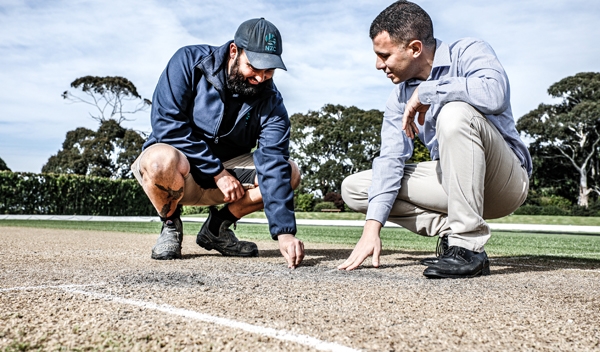AVANEX® FAQ's
What is AVANEX® Unique Endophyte Technology turfgrass?
AVANEX® Unique Endophyte Technology is currently available in one perennial ryegrass turf cultivar and one tall fescue turf cultivar. The grasses have been bred with special novel endophytes that produce high levels of alkaloids that provide them with a level of resistance to insect feeding. Both turfgrass species produce high levels of ergovaline a chemical known to be a feeding deterrent. Both also produce peramine a well-known insecticidal compound with a small target pest range, but with no known mammalian toxicity. The fescue version also produces loline which is a well-known broadly insecticidal compound with no known mammalian toxicity.
The protection afforded by these alkaloids results in turfgrasses that are hardier than usual against drought and other abiotic stresses and results in better persistence of the turfgrasses when faced with moderate seasonal drought. Another consequence of the high alkaloid production is fewer insects which may result in fewer insectivorous birds such as starlings. When turfgrass with AVANEX® is eaten by herbivorous birds such as Canada geese they feel unwell and associate the AVANEX® grass with that bad experience, so they feed elsewhere, provided they have the choice. It also appears that AVANEX® unique endophyte technology turfgrass also affects small animals like rabbits which eat the grass, and as a result do not continue to feed on the AVANEX®, leading to less damage.
What are the benefits of AVANEX®?
Turfgrasses with AVANEX® may be expected to be less attractive to feeding by herbivorous birds such as geese and insectivorous birds such as starlings. This can be a benefit for parks, golf courses and airports. Damage to horticultural, vine and tree crops from problem herbivorous animals may be reduced by planting their tracks with AVANEX® turfgrass.
AVANEX® turfgrass is protected from many above ground feeding insect pests thereby reducing the need for insecticide applications.
Are the alkaloids produced by AVANEX® harmful and what precautions should be taken when using it?
To date there is no information to indicate turfgrass with AVANEX® will cause harm to humans or to the environment. The AVANEX® alkaloids act primarily as feeding deterrents.
Turfgrasses or clippings from turfgrasses with AVANEX® Unique Endophyte Technology should not be fed to animals. Ingestion of the seed or the grass can cause severe adverse animal health issues and is not to be provided as feed for animals or birds. In severe situations it may cause death to grazing animals.
AVANEX® grass should be kept mowed to prevent seedhead formation.
How are herbivorous birds such as Canada geese deterred by turfgrasses with AVANEX®Unique Endophyte Technology?
Herbivorous birds such as Canada geese are deterred by a process called post-ingestion malaise. When geese are fed on turfgrass with AVANEX® the alkaloids present make them feel unwell. They learn to associate the AVANEX® grass with this bad experience and choose to feed elsewhere provided they have the choice.
When will AVANEX® not deter herbivorous birds such as Canada geese?
It is important to understand that herbivorous birds need to be feeding on the AVANEX® turfgrass to trigger the deterrent effect. Where birds are being fed by humans, or have moved to a safe place to rest or loaf and are not feeding, there is unlikely to be deterrent effect.
How does turfgrass with AVANEX® deter insectivorous birds such as starlings?
The high levels of alkaloids produced by AVANEX® turfgrass generally results in lower numbers of some insects, resulting in less food for insectivorous birds such as starlings.
Can turfgrass with AVANEX® deter other herbivorous animals?
A study with captive rabbits also indicated the same pattern of learned aversion as for Canada geese. It is possible that other herbivorous animals could be similarly deterred.
Are all insects affected by AVANEX®?
The production of alkaloids in turfgrass with AVANEX® is concentrated close to the grass crown area at and above the soil surface. A small amount of alkaloid moves up into the leaves and into the roots. The insects most affected by the alkaloids are those that feed on or about the grass crown. This includes many caterpillars, beetles and weevils. In tall fescue below ground feeding white grubs and chafer grubs can be moderately deterred by downward moving lolines. Molluscs and earthworms are generally not significantly affected.
What areas can benefit from using AVANEX®?
AVANEX® Unique Endophyte Technology is well suited for use at airports to potentially help reduce bird numbers and the need for bird dispersals. It is also suited to parkland and golf course situations where geese can be a problem, provided the geese are feeding on the grass and not being fed by humans. It has been used successfully on sports fields to deter problem birds. An interesting possible use is as a cover crop for tracks between rows of vine crops as a problem grazing animal deterrent and a possible insect pest reduction.
What climates are suitable for turfgrasses with AVANEX® and how is it best established?
The tall fescue and perennial ryegrass with AVANEX® Unique Endophyte Technology are generally adapted to the cool, humid regions in the Coppen climate classification. Tall fescue and perennial ryegrass have different zones of adaptation, so the choice of species needs to be made on a site specific basis.
To achieve the best performance from turfgrass with AVANEX® it needs to completely replace any existing turfgrass and prevent invasion by other grass. The existing grass cover needs to be destroyed and re-sown with AVANEX® turfgrass. Do not sow turfgrass with AVANEX® in a mixture with non-AVANEX® grass. For airports, a best practice guide has been developed to minimise the risk of attracting birds by activities associated with sowing AVANEX® grass.
HOW IS TURFGRASS WITH AVANEX® SPECIFIED? HOW IS IT DIFFERENT FROM OTHER TURFGRASS?
Turfgrass with AVANEX® Unique Endophyte Technology can be specified as AVANEX® tall fescue or AVANEX® perennial ryegrass. The current cultivars are AVANEX® Lagertha tall fescue with AR601 endophyte and AVANEX® Colosseum perennial ryegrass with AR95 endophyte, with more cultivar choices planned. A technical specification is: A turf tall fescue or turf perennial ryegrass with seed containing over 70% live endophyte tested within three months of sowing using a ‘grow out live endophyte test’. The endophyte shall be one demonstrated to produce high levels of ergovaline.
It is most important that the specification includes a recent live endophyte test. Live endophyte can readily drop to low levels with poor seed storage for over three months in warm humid conditions. Seed stored in humidity controlled cool storage at 5°C and 30% RH retains its germination and endophyte viability, so a test up to one year old should still be valid. Seed is sometimes claimed to be high endophyte from a test carried out at the time of breeding or harvest. The same seed can often be found on delivery to have low levels of viable endophyte due to improper storage.
A number of other turfgrass cultivars have different levels of endophyte infection, but none are specifically bred with endophytes selected to produce high levels of ergovaline alkaloid. Only by testing seed lines using a ‘viable endophyte grow out test’ (taken close to sowing) can the level of viable endophyte be authentically verified.
AVANEX® Cultivars
AVANEX® Unique Endophyte Technology has been included in turf-type grasses, Lagertha - a turf tall fescue, and Colosseum - a turf perennial ryegrass. These endophytes can produce high quantities of alkaloids that can reduce a number of insect pests while also being a deterrent to wildlife grazing.
AVANEX® Colosseum

AVANEX® Colosseum is a medium-fine, mid-green, perennial ryegrass that is a cross between Mediterranean and American genetics. The Mediterranean genetics gives the turf active winter growth in cooler weather and rapid germination, especially in cold temperatures down to 5°C.
- Fast germination
- Winter active Mediterranean genetics
- Wear resistance and recovery
- Attractive glossy mid-green colour
- Contains AVANEX® AR95 Unique Endophyte Technology
AVANEX® Lagertha tall fescue

Lagertha, with AVANEX® Unique Endophyte Technology, is a high quality, dark and fine turf tall fescue. Lagertha retains a green colour and an attractive appearance for longer in summer due to its strong deep root system.
- Moderately fine, dense turf type tall fescue
- Dark green with excellent colour retention
- Excellent persistence without irrigation
- Contains AR601 Unique Endophyte Technology
- Reduced mowing frequency
- Mowing height between 50 - 150 mm



